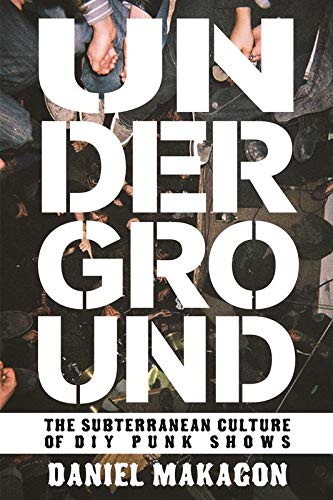
Pure punk rock, regardless of a band’s popularity or the decade in which they’ve performed, has pretty much been an underground form of music. Long associated with violence, destruction, and all-around malfeasance, young punk bands have always had a hard time getting gigs in normal, clean-cut venues.
Daniel Makagon’s book, Underground: The Subterranean Culture of DIY Shows covers the scene in cities and towns of all sizes across the U.S., proving that punk is alive and well in places other than New York and Southern California. This informative, 192-page book is packed with interviews and histories of the DIY punk scene in Denver, Wisconsin, Boston, Florida, Iowa, and Baltimore, among others. Makagon doesn’t spend a lot of time describing the trivialities of band life or any of the fights that often ensue between performers. Instead, he focuses on the ways fans, bands and DIY promoters arrange and set up shows. If you’re into punk rock (and might even be interested in setting up your own DIY shows), this book is indispensable. From punk shows in backyards and basements to community centers, public spaces, and non-profits, DIY punk shows are still going strong on 2015.
Free or cheap entry ($3 for seven bands is a common price) and cheaper beer makes most DIY punk shows more like a party than an organized rock show. There’s C-Squat in New York City, a haven for punk shows, which is in the process of becoming a co-op owned by former squatters. 924 Gilman in West Berkeley introduced Green Day, Rancid, and the Offspring to the world and it’s still going strong.
The DIY ethic took flight in the late ‘70s and ‘80s, before it was common to be heard without a record company or manager. In the ‘80s, before the internet and social media, when flyers, zine listings, and word of mouth were the primary marketing methods, kids worked extra hard to get the word out. Now, with social media, it’s easier for fans and bands to communicate, giving punk bands and promoters a tighter berth.
Underground: The Subterranean Culture of DIY Shows covers the beginnings of DIY in the 1980s to the burgeoning underground scene of the 1990s to the present, using sources from Maximum Rock and Roll articles to interviews with punk band members, promoters, and scenesters. Makagon, an associate professor in the College of Communication at Chicago’s DePaul University, takes a common sense, journalistic approach to the history- and future – of DIY punk venues in the U.S.